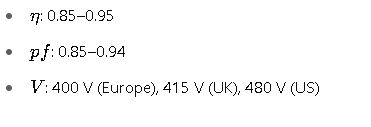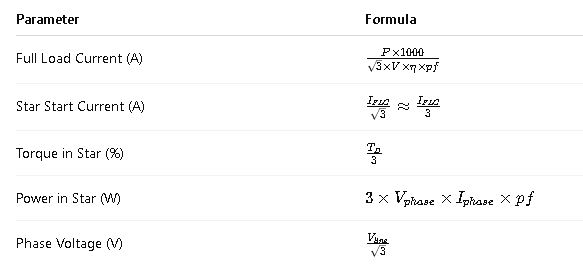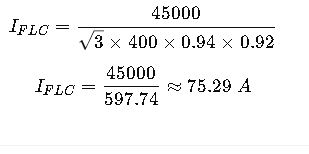The Star-Delta starter reduces inrush current in three-phase motors, minimizing mechanical stress during startup.
This guide offers detailed formulas, variable explanations, tables, and real examples for industrial motor applications.
Star-Delta Starter Current Calculator
Common Values Used in Star-Delta Starting Calculations
The following table contains typical motor specifications and their associated calculated values when using Star-Delta starting. These are based on common industrial scenarios with standard motor parameters.
Table 1: Common Motor Ratings and Star-Delta Starting Parameters
| Motor Power (kW) | Voltage (V) | Full Load Current (A) | Star Starting Current (A) | Delta Running Current (A) | Star-Delta Inrush Ratio | Power Factor (pf) | Efficiency (%) |
|---|---|---|---|---|---|---|---|
| 5.5 | 400 | 10.5 | 3.5 | 10.5 | 1:3 | 0.85 | 89 |
| 7.5 | 400 | 14.8 | 4.9 | 14.8 | 1:3 | 0.86 | 90 |
| 11 | 400 | 21.5 | 7.2 | 21.5 | 1:3 | 0.88 | 91 |
| 15 | 400 | 29.2 | 9.7 | 29.2 | 1:3 | 0.89 | 92 |
| 18.5 | 400 | 35.5 | 11.8 | 35.5 | 1:3 | 0.90 | 92 |
| 22 | 400 | 42.1 | 14.0 | 42.1 | 1:3 | 0.91 | 93 |
| 30 | 400 | 57.4 | 19.1 | 57.4 | 1:3 | 0.92 | 93 |
| 45 | 400 | 84.5 | 28.2 | 84.5 | 1:3 | 0.92 | 94 |
| 55 | 400 | 103.0 | 34.3 | 103.0 | 1:3 | 0.93 | 94 |
| 75 | 400 | 139.8 | 46.6 | 139.8 | 1:3 | 0.94 | 95 |
Note: The Star-Delta starting current is approximately one-third of the full-load current in Delta mode. Values are based on standard IEC 60034 assumptions.
Formulas for Star-Delta Starting Calculation
A correct design involves several interrelated electrical formulas. Below are the essential equations and variables for accurate calculation.
Full Load Current (FLC)

Common values:

Star Starting Current
- Istart= Starting current in Star mode
This formula assumes ideal conditions. In reality, motor type and torque characteristics can slightly change the ratio.
Starting Torque in Star

Line Current in Delta
But in Star connection:
Power Consumed During Start (Star)
Where:

Transition Time
There is no fixed formula, but per IEC 60947-4-1:
Typical transition time: 2–15 seconds depending on load inertia.
Motor manufacturers or field testing determine this time more precisely.
Practical Formula Summary Table
Real-World Example 1: 15 kW Motor at 400 V, 50 Hz – Water Pump Application
Motor Nameplate Data:
| Parameter | Value |
|---|---|
| Power | 15 kW |
| Voltage | 400 V |
| Frequency | 50 Hz |
| Power Factor | 0.89 |
| Efficiency | 92% (0.92) |
| Connection Type | Star-Delta |
| Service Factor | 1.0 |
Step 1: Calculate Full Load Current (FLC)
Step 2: Calculate Star Starting Current
Step 3: Select Contactors (According to IEC 60947)
Contactors Required:
- Main Contactor (KM1) → must handle star current (approx. 8 A)
- Delta Contactor (KM2) → must handle full-load current (24 A)
- Star Contactor (KM3) → must handle phase current (24 ÷ √3 ≈ 13.86 A)
Standard used: IEC 60947-4-1 defines utilization category AC-3 for motor starters.
Recommended Contactors:
- KM1 (Main): 25 A AC-3
- KM2 (Delta): 25 A AC-3
- KM3 (Star): 16 A AC-3
Step 4: Set Overload Relay
Overload relays are selected based on full load current, with a margin of 5–10%.
- Overload range: 22 A – 26 A
- Setpoint: ≈ 24 A
Step 5: Verify Suitability
- Starting current is reduced to 7.87 A
- Motor torque reduced to ~33%
- Transition time: 6–8 seconds (measured during commissioning)
This setup is safe for low-inertia loads like centrifugal pumps, where reduced torque is acceptable.
Real-World Example 2: 45 kW Motor at 400 V – HVAC Fan System
Motor Nameplate Data:
| Parameter | Value |
|---|---|
| Power | 45 kW |
| Voltage | 400 V |
| Frequency | 50 Hz |
| Power Factor | 0.92 |
| Efficiency | 94% (0.94) |
| Connection Type | Star-Delta |
| Service Factor | 1.15 |
Step 1: Calculate Full Load Current (FLC)
Step 2: Star Starting Current
Step 3: Select Contactors
Required contactors:
| Contactor | Duty | Current Rating (AC-3) |
|---|---|---|
| KM1 | Main | ≥ 80 A |
| KM2 | Delta | ≥ 80 A |
| KM3 | Star | ≥ 46 A |
Recommended: Choose contactors with at least 10% headroom for thermal capacity.
Step 4: Select Overload Relay
- Range: 72 A – 85 A
- Trip Class: 10A or 10B (for HVAC fans)
- Ensure relay has phase-loss protection
Step 5: Evaluate Suitability
- Starting current limited to ~25 A
- Startup torque reduced, but sufficient due to fan’s low torque demand
- Smooth transition observed within 5 seconds
Ideal configuration for ventilation systems that operate in long duty cycles with soft starts.
Common Application Areas for Star-Delta Starting
| Industry Sector | Typical Motor Use | Reason for Star-Delta |
|---|---|---|
| Water Treatment Plants | Pumps, blowers | Minimize surge loads |
| HVAC Systems | Air handlers, large fans | Reduce mechanical wear |
| Manufacturing | Conveyor belts, machine tools | Protect drive systems |
| Mining Industry | Crushers, compressors | Controlled acceleration |
| Agricultural Irrigation | Deep well pumps | Lower grid disturbance |
Key Notes and Recommendations
- Use Star-Delta only when:
- Motor is rated above 5.5 kW
- Load allows reduced torque during start
- Electrical network can’t handle direct-on-line (DOL) inrush
- Ensure:
- Contactors are mechanically interlocked
- Transition delay is appropriate to prevent current peaks
- Correct thermal protection is applied
- Bypass resistors are used when needed for smooth switching










